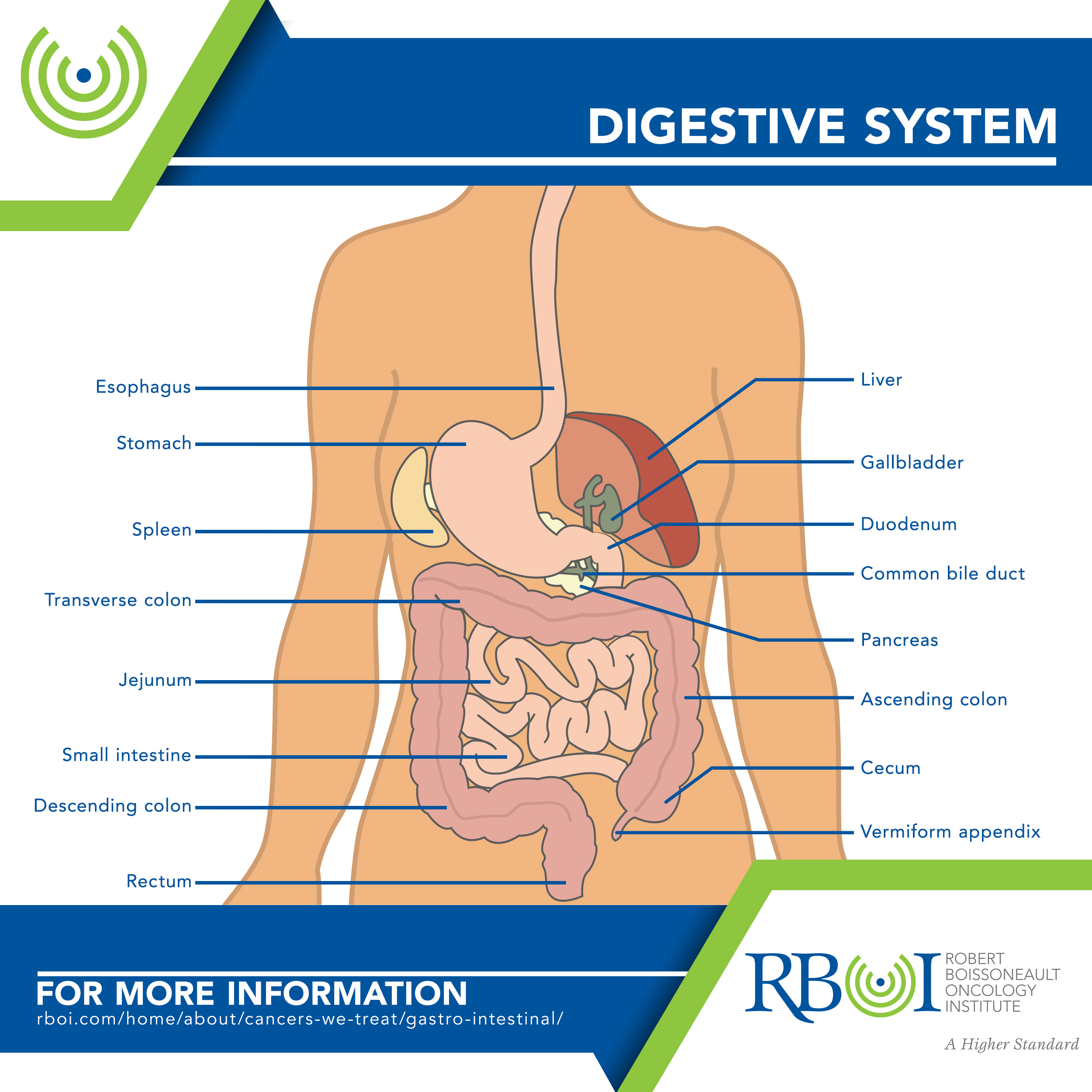Esophageal Cancer
The esophagus is a 10-inch long, hollow, muscular tube that connects the throat to the stomach. Esophageal cancer starts in the inner layer of the esophagus and grows outward.
-
Forms of esophageal cancer
Squamous cell carcinoma starts in squamous cells that line the esophagus. It usually develops in the upper and middle part of the esophagus. Squamous cell carcinoma used to be the most common type of esophageal cancer in the US, but now accounts for less than half of cases.
Adenocarcinoma begins in the glandular tissue in the lower part of the esophagus where the esophagus and the stomach come together.
-
Risk factors for esophageal cancer
Achalasia, Age, Alcohol, Barrett’s esophagus, Diet, Gastroesophageal reflux disease (GERD), Gender, History of some other cancers, Human papillomavirus (HPV), Injury to the esophagus, Obesity, Plummer-Vinson syndrome, Race, Tobacco, Tylosis, Workplace exposures
Achalasia — In this condition, the lower muscular ring of the esophagus does not relax as food is swallowed. Achalasia increases the risk of squamous cell carcinoma.
Age — People between the ages of 45 and 70 have the highest risk of esophageal cancer. Less than 15 percent of cases are found in people younger than age 55.
Alcohol — Heavy drinking over a long period of time increases the risk of esophageal cancer, especially the squamous cell type. The risk increases further when combined with tobacco use.
Barrett’s esophagus — This condition can develop in some people who have chronic gastroesophageal reflux disease (GERD) or inflammation of the esophagus called esophagitis. People with Barrett’s esophagus are more likely to develop adenocarcinoma of the esophagus, but the risk of developing esophageal cancer is still fairly low.
Diet — A diet low in fruits and vegetables and certain vitamins and minerals can increase the risk of developing esophageal cancer. Frequently drinking very hot liquids (temperatures of 149° F or 65° C – much hotter than a typical cup of coffee) may damage cells lining the esophagus and increase the risk for the squamous cell type of esophageal cancer.
Gastroesophageal reflux disease (GERD) — People with GERD (a condition in which stomach acid rises into the lower part of the esophagus) have a slightly higher risk of getting adenocarcinoma of the esophagus. This risk seems to increase in people who have more frequent symptoms.
Gender — Men are 3 to 4 times more likely than women to develop esophageal cancer.
History of some other cancers — People with a history of lung, mouth, or throat cancer are at high risk of getting squamous cell carcinoma of the esophagus, possibly with smoking as the underlying cause.
Human papillomavirus (HPV) — Signs of HPV infection have been found in up to one-third of esophagus cancers from patients in parts of Asia and South Africa, but have not been found in esophagus cancers from patients in the other areas, including the US. Researchers are investigating HPV as a risk factor for esophageal cancer, but have not found a clear link.
Injury to the esophagus — Children who have accidently swallowed lye (found in some cleaning products, such as drain cleaners) have an increased risk of squamous cell carcinoma. Lye can cause a severe chemical burn in the esophagus. As the injury heals, scar tissue can cause an area of the esophagus to become very narrow (called a stricture). People with these strictures have an increased risk of squamous cell esophageal cancer, which often occurs years (even decades) later.
Obesity — Being severely overweight and having too much body fat can increase the risk of developing esophageal adenocarcinoma.
Plummer-Vinson syndrome — People with this rare condition (also called Paterson-Kelly syndrome) have webs in the upper part of the esophagus, typically along with anemia due to low iron levels, tongue irritation (glossitis), brittle fingernails, and sometimes a large thyroid gland or spleen. About 1 in 10 people with this syndrome eventually develop squamous cell cancer of the esophagus or cancer in the lower part of the throat (hypopharynx).
Race — Black people are twice as likely as white people to develop the squamous cell type of esophageal cancer.
Tobacco — Using any form of tobacco raises the risk of esophageal cancer. Smoking a pack or more of cigarettes per day at least doubles the chance of getting adenocarcinoma of the esophagus compared to nonsmoker, and the risk does not go away if tobacco use stops. The link to squamous cell esophageal cancer is even stronger, but this risk decreases if tobacco use stops.
Tylosis — People with this rare, inherited condition develop small growths (papillomas) in the esophagus and have a very high risk of getting squamous cell cancer of the esophagus. Regular monitoring with an upper endoscopy is recommended.
Workplace exposures — Exposure to chemical fumes in certain workplaces may lead to an increased risk of esophageal cancer. Some (but not all) studies have found that dry cleaning workers may have a higher rate of esophageal cancer.
-
Symptoms of esophageal cancer
Difficulty and pain with swallowing, particularly when eating meat, bread, or raw vegetables. This is the most common symptom of esophageal cancer. This symptom is often mild at first and worsens over time as the growing tumor blocks more of the opening inside the esophagus. Even liquid may be painful to swallow. To help pass food through the esophagus, the body makes more saliva. This causes some people to complain of bringing up lots of thick mucus or saliva.
Pressure or burning in the chest behind the breastbone, or in the throat. Pain may be felt in the middle of the chest a few seconds after swallowing, as food or liquid reaches the tumor and has trouble getting past it.
Unexplained weight loss. About half of people with esophageal cancer lose weight without trying to. Their swallowing problems keep them from eating enough to maintain their weight. Their appetite may decrease, and cancer may cause their metabolism to increase.
-
Additional symptoms of esophageal cancer
Indigestion or heartburn
Vomiting
Frequent choking on food
Coughing or hoarseness
Hiccups
Bone pain
Bleeding into the esophagus. This blood then passes through the digestive tract, which may turn the stool black. Over time, this blood loss can lead to anemia.
-
How is esophageal cancer treated with radiation?
External-beam radiation therapy (EBRT), delivered from outside the body, is the type of radiation therapy used most often to treat esophageal cancer. A plastic tube may be inserted into the esophagus to keep it open during radiation therapy. This is called intraluminal intubation and dilation.
Internal radiation therapy (brachytherapy) delivers radioactive material internally via an endoscope, a long, flexible tube that is passed down the throat. Radiation travels only a short distance to the tumor and has little effect on nearby normal tissues.
Radiation may be part of the main treatment of esophageal cancer in some patients, typically along with chemotherapy. This is often used for people who can’t have surgery due to poor health or for people who don’t want surgery.
Radiation may be used before surgery (and with chemotherapy when possible) to try to shrink the cancer and make it easier to remove.
Radiation may be used after surgery (and with chemotherapy when possible) to try to kill any areas of cancer cells that may have been left behind but are too small to see.
Radiation may be used as palliative therapy to ease the symptoms of advanced esophageal cancer such as pain, bleeding, or trouble swallowing.
Proton beam therapy is being studied in clinical trials for esophageal cancer. Proton beam therapy is a type of external-beam radiation therapy that uses protons rather than x-rays.

Click here to learn more about RBOI’s radiation treatment options
Click here to watch a walk-through of what is involved in radiation treatment at RBOI
More extensive information about esophageal and other cancers may be found at these sites:
American Cancer Society: Cancer.org
American Society of Clinical Oncology: Cancer.net
National Cancer Institute: Cancer.gov
